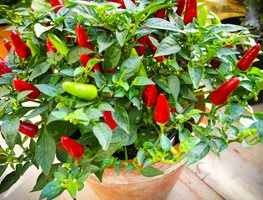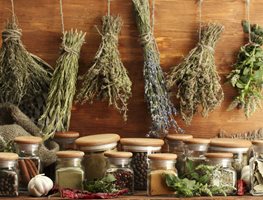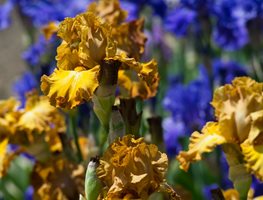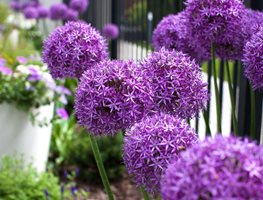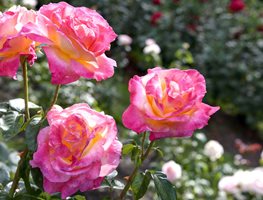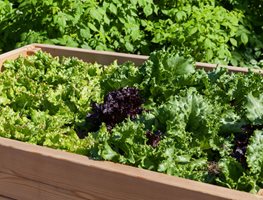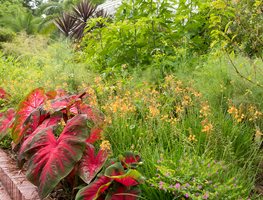10 Gardening Activities for August in the South
Be sure to keep a watchful eye on your garden this month. Look for pest issues and also plants that need extra water or protection. Here are garden tasks, tips, ideas, chores, and places to visit this month.
1. Care for Summer Crops
The vegetables, herbs, and fruits in your garden will be prolific this month. Be sure to continuously harvest produce so it doesn’t go to waste or drop to the ground (which will attract pests). Also, many plants such as green beans, basil, tomatoes, peppers, chives, and lettuce yield better crops when harvested regularly. While harvesting, be sure to look for pests and disease on plants. For example, if you see worms on tomato plants, you should remove them by hand and dispose of them. If you see indication of disease on any plants, remove affected foliage as soon as possible and dispose of it. Protect plants with neem oil.
2. Save Your Summer Bounty
Some people love canning and preserving while others swear by drying herbs and freezing other produce. Whatever you’re most comfortable with, be sure to order supplies such as mason jars, freezer bags, twine, and other items so you have them on hand as the season progresses. If you know you won’t use all your produce and don’t plan to give it away, try saving batches each week. Label containers with the date so you know when you harvested it. Learn easy ways to preserve your harvest.
3. Blooming Now
Ever-reliable asters are starting to bloom this month. The pollinators are probably as happy to see them as you are!
Agapanthus will carry your garden from these summer days into early fall, and the foliage is always there to greet you. If you have them in a container, remember to repot from time to time as they don’t enjoy being root-bound.
Marigolds are great to have planted in (or even near) your vegetable garden as they attract and deter all the right pollinators, critters, and bugs!
4. Give Topiaries & Hedges a Final Haircut
Many varieties of topiary and hedges start going dormant in November and December. So if you trim later than the end of August, there’s a chance that the new growth won’t be able to harden off before the first freeze. This will destroy new growth and cause unsightly dieback that you will have to cut back harder next season.
5. Continue Planting & Dividing Irises
You can start planting irises this month. They usually do best when planted between August and October, according to the American Iris Society. The fall months typically bring rain which helps supplement watering. Order new varieties online from sources such as Schriener’s Iris Gardens or Rainbow Iris Farm. If you already have irises in your garden that are looking crowded, dig up clumps and divide them with a clean spade during a cooler time of day. Once clumps are out of the ground, move them to the shade so they don’t dry out. After dividing them, replant them as soon as possible. This is a quick visual rundown of how to divide irises.
Don't miss what to do in the garden each month, make sure you're getting our weekly newsletter.
6. Order Bulbs
Though you probably won’t be planting bulbs for another month or two, now is the time to make your selections and place an order. If you don’t do it now many of the bulb suppliers will sell out of the best selections. One tip: Order in bulk from sources that sell in large quantities such as Van Engelen Inc. who sells bulbs in sets of 50, 100, 500, 1,000, and more. It’s much more cost effective to buy them this way. Just make sure you’re ready to do some planting! (If you don’t think you’ll plant them all, find a neighbor or friend who is also looking to plant bulbs so you can go in on the cost together.) The impact on your garden next spring will be magical. Bulb suppliers also have pages with suggestions such as the best bulbs to grow in warmer climates or daffodils that love heat.
7. Give Your Roses Some Love
Keep a watchful eye on your roses and continue spraying them with organic fungicide to prevent disease. You’ll also want to stop fertilizing roses this month. If you see signs of disease, remove affected foliage as soon as possible and dispose of it. Get more rose care tips.
8. Plant Conifers Now and Into the Fall
When planting conifers you want to make sure they have adequate time to root before the ground begins to freeze. In most areas of the South, planting in late August and into the fall will provide adequate warmth for root growth and enough time for roots to establish. Keep plants consistently watered until rain or snow increases the natural moisture level of the soil. Visit Singing Tree Gardens Nursery to buy online or purchase at your local nursery.
9. Plant Cool-Season Crops
Prepare beds by removing warm-weather crops that are ready to be turned. Cover beds with a 2- to 4-inch layer of compost. Direct sow beans, beets, spinach, mesclun, tatsoi, and other crops appropriate for fall planting. It’s best to plant crops like broccoli, cabbage, and cauliflower from starts rather than seeds. Always look at your area’s first frost date to determine which crops are appropriate to plant right now.
10. Visit Southern Gardens(in person or from home)
There are many extraordinary gardens, so we created a collection of self-guided day trips with beautiful photos to browse from home, along with insights and information to help you plan your next trip and make the most of your time in each location!
Atlanta Day Trip: Explore the Japanese Garden at Gibbs Garden, the Goizueta Gardens at the Atlanta History Center, and the 22-mile loop of the Atlanta Beltline with local garden expert and author Helen Lawson as your guide.
Orlando Day Trip: Landscape designer and radio show host Teresa Watkins shares her 3 favorite gardens; Harry P Leu Botanical Garden (pictured), the 3 blocks of Central Park, and the Mead Botanical Garden.
If you enjoyed this information, sign up for our weekly newsletter. Each week, you'll get Garden Design's best delivered right to your inbox including design tips, plant picks, great gardens, outdoor living products, and events to enjoy — along with monthly gardening checklists just for your area.
Do you know someone who would enjoy this Southern Region gardening information? Why not share it with them?
When you purchase products through links on our site, we may receive an affiliate commission. Thank you for your support.
